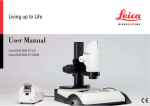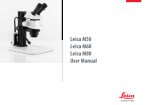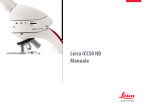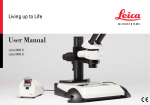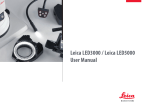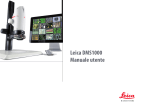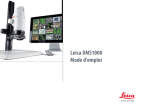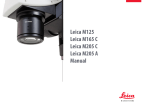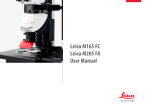Download Leica DMS1000 User Manual
Transcript
Leica DMS1000 User Manual Contents General Notes General Notes Important Safety Notes Symbols Used Safety Instructions 5 6 7 8 Objective and Illumination Standard Objective Objective with Telecentric Optics Illumination: Leica LED3000 RL Illumination: Leica LED3000 NVI™ Illumination: Leica LED5000 SLI, Leica LED3000 SLI 24 24 25 27 29 30 Introduction Congratulations! Standard Delivery and Optional Accessories System Overview Overview of the Instrument Effective Displayed Section 11 12 13 14 15 Installation HD Mode (Standalone) Cables and Terminals, Activating HD Mode (Standalone) PC Mode Connecting a Computer, Installing Software, Activating PC Mode Limitations in PC Mode 33 33 34 34 35 Assembly Leica DMS1000 with Incident Light Base Incident Light Base and Focusing Column Microscope Carrier and Leica DMS1000 Leica DMS1000 with Transmitted Light Base Transmitted Light Base and Focusing Column Microscope Carrier and Leica DMS1000 Leica DMS1000 with Swing-arm Stand Baseplate and Vertical Column Safety Ring and Horizontal Arm Microscope Carrier and Leica DMS1000 17 17 18 19 19 20 21 21 22 23 Startup Procedure Leica DMS1000 Switching on the Leica DMS1000 Switching on the Illumination Focusing, Adjusting the Resistance of the Focus Drive Changing Magnification, Click-stop Feature Remote control "Pairing" the Leica DMS1000 with a Remote Control Configuring the Front Button or Footswitch 37 37 38 39 40 41 43 44 Leica DMS1000 User Manual Contents (Continued) Operation Operation in HD Mode (Standalone) Checking Cables and Terminals Switching on the Leica DMS1000 Information about SD Memory Cards Capturing Images without a Computer Displaying Images and Videos without a Computer White Balance PC Mode Checking Cables, Terminals and Software Switching on the Leica DMS1000 Additional Use of an HD Monitor in PC Mode 47 47 48 49 50 51 52 53 53 54 55 User Menu Calling up the User Menu Automatic white balance Manual white balance Exposure Resolution Camera Settings User-defined Settings Setting the overlay (SETUP OVERLAY) Scalable Display Configuring Predefined Illumination Scenarios 57 58 59 60 61 63 65 67 69 70 Leica DMS1000 User Manual Service Care, Maintenance, Contact Persons Spare parts 72 75 Specifications Technical Data Optical Data - Field of View Optical Data - Magnification and Depth of Field Dimensional Drawings Leica DMS1000 Leica DMS1000 with Incident Light Base Leica DMS1000 with Incident Light Base Leica DMS1000 with Transmitted Light Base Leica DMS1000 with Swing-arm Stand 77 81 82 84 84 85 86 87 88 General Notes Leica DMS1000 User Manual General Notes 4 General Notes Safety concept Before using your Leica microscope for the first time, please read the "Safety Concept" brochure included with your instrument. It contains additional information on handling and care. Use in clean rooms The Leica DMS1000 digital microscope system can be used in clean rooms without any problems. Cleaning Do not use any unsuitable cleaning agents, chemicals or techniques for cleaning. Ϙ Leica DMS1000 User Manual Ϙ Never use chemicals to clean colored surfaces or accessories with rubberized parts. This could damage the surfaces, and specimens could be contaminated by abraded particles. Ϙ In most cases, we can provide special solutions on request. Some products can be modified, and we can offer other accessories for use in clean rooms. General Notes Servicing Repairs may only be carried out by Leica Microsystems-trained service technicians. Only original Leica Microsystems spare parts may be used. Ϙ Responsibilities of person in charge of instrument Ϙ Ensure that the Leica microscope is operated, maintained and repaired by authorized and trained personnel only. 5 Important Safety Notes User Manual The Leica DMS1000 can be configured in a variety of ways in the Leica product range. You can find information on individual system components on the interactive CD-ROM together with all relevant user manuals in additional languages. Keep this CD-ROM in a safe place, where it is available to the user. User manuals and updates are also available for you to download and print from our website www.leicamicrosystems.com This operating manual describes the special functions of the Leica DMS1000 digital microscope system and contains important instructions for its operational safety, maintenance, and accessories. Leica DMS1000 User Manual The "Safety Concept" booklet contains additional safety information regarding the service work, requirements and the handling of the microscope, accessories and electrical accessories as well as general safety instructions. To maintain the unit in its original condition and to ensure safe operation, the user must follow the instructions and warnings contained in these user manuals. You can combine individual system articles with articles from external suppliers (e.g. cold light sources, etc.). Please read the User Manual and the safety instructions from the supplier. Before installing, operating or using the instruments, read the user manuals listed above. In particular, please follow all safety instructions. General Notes 6 Symbols Used Warning! Safety hazard! This symbol indicates especially important information that is mandatory to read and observe. Warning of hazardous electrical voltage This symbol indicates information that must be read and observed. Danger due to hot surface. This symbol warns against touching hot surfaces, e.g. those of light bulbs. Failure to comply can cause the following: Failure to comply can cause the following: Ϙ Ϙ Hazards to personnel Functional disturbances or damaged instruments Leica DMS1000 User Manual Ϙ Ϙ Hazards to personnel Functional disturbances or damaged instruments General Notes Important information This symbol indicates additional information or explanations that are intended to provide clarity. 7 Safety Instructions Description The individual modules fulfill the highest requirements for observation and documentation with the Leica DMS1000 digital microscope system. altered, modified or used in conjunction with non-Leica components that are outside of the scope of this manual! Intended Use Ϙ Refer to "Safety Concept" booklet Unauthorized alterations to the instrument or noncompliant use shall void all rights to any warranty claims. Ϙ Non-intended use Ϙ Refer to "Safety Concept" booklet Never use the Leica DMS1000 or its components for surgical procedures (such as eye surgery) since it is not intended for such use. The instruments and accessories described in this User Manual have been tested for safety and potential hazards. The responsible Leica affiliate must be consulted whenever the instrument is Leica DMS1000 User Manual Place of use Ϙ Refer to "Safety Concept" booklet Ϙ Electrical components must be placed at least 10 cm away from the wall and from flammable substances. Ϙ Avoid large temperature fluctuations, direct sunlight and vibrations. These conditions can distort measurements and micrographic images. General Notes Ϙ In warm and warm-damp climatic zones, the individual components require special care in order to prevent the build-up of fungus. Responsibilities of person in charge of instrument Ϙ Refer to "Safety Concept" booklet Ensure that: Ϙ The Leica DMS1000 digital microscope system and accessories are operated, maintained and repaired by authorized and trained personnel only. Ϙ All operators have read, understood and observe this User Manual, and particularly the safety regulations. 8 Safety Instructions (continued) Repairs, service work Refer to "Safety Concept" booklet Ϙ Ϙ Only original Leica Microsystems spare parts may be used. Ϙ Before opening the instruments, switch off the power and unplug the power cable. Ϙ Avoid contact with powered electrical circuits, which can lead to injury. Transport Ϙ Use the original packaging for shipping or transporting the individual modules of the Leica DMS1000 digital microscope system and the accessory components. Ϙ In order to prevent damage from vibrations, disassemble all moving parts that (according to the user manual) can be assembled and disassembled by the customer and pack them separately. Leica DMS1000 User Manual Integration in third-party products Refer to "Safety Concept" booklet Ϙ Disposal Ϙ Refer to "Safety Concept" booklet Legal regulations Ϙ Refer to "Safety Concept" booklet EC Declaration of Conformity Ϙ Refer to "Safety Concept" booklet Ϙ Optimal arrangement of workplace, work assignments and work flow (changing tasks frequently). Ϙ Thorough training of the personnel, giving consideration to ergonomic and organizational aspects. The ergonomic optics concept and the design of the Leica DMS1000 digital microscope system aim to limit the strain on the user to the lowest possible level. Health risks Workplaces with microscopes facilitate and improve the viewing task, but they also impose high demands on the eyes and holding muscles of the user. Depending on the duration of uninterrupted work, asthenopia and musculoskeletal problems may occur. For this reason, appropriate measures for reduction of the workload must be taken: General Notes 9 Introduction Leica DMS1000 User Manual Introduction 10 Congratulations! Congratulations on purchasing the Leica DMS1000 digital microscope system by Leica Microsystems. The special design of the Leica DMS1000 makes it a universal, highly versatile tool for viewing microscopic specimens and capturing still images or even video. Real Full HD display The integrated HDMI output allows the microscope image to be output to a high-definition (HD-capable) monitor, where the following resolutions are possible: Ϙ 1920×1080 (Full HD). This resolution provides the best possible imaging performance on a Full HD-capable monitor. Ϙ 1280×720 (HD ready). This resolution is suitable for display on monitors labeled "HD ready" or on smaller screens with a 10" or 12" diagonal. Leica DMS1000 User Manual Leica Application Suite Your Leica DMS1000 digital microscope system includes the "Leica Application Suite" (LAS) software. It allows additional scenarios to be implemented in which an HD monitor and computer monitor can even be used together. This means you will be perfectly equipped for any situation, including: Working on a computer, during presentations, training sessions, trade show appearances, during materials testing and more. User-friendly even in the smallest detail Like every digital camera, the Leica DMS1000's integrated camera reacts differently to different light sources. However, the white balance is matched to LED illuminators from Leica at the factory. This means that if you use a Leica LED illuminator, you automatically obtain the best results! There are countless (optionally available) LAS modules to choose from if you want to perform demanding image analyses. Introduction 11 Standard Delivery and Optional Accessories Optional accessories: Handswitch/footswitch Standard delivery The Leica DMS1000 digital microscope system's standard delivery includes: 3 4 5 6 2 3 4 5 6 7 8 1 Leica DMS1000 digital microscope system, without objective 2 remote control units, with battery Connection for optional footswitch USB cable, for connecting to a computer or to a power supply unit for supplying power HDMI cable, for connecting to an HD monitor SD memory card Protective cover "Leica Application Suite (LAS)" software DVD B O K W B Additional information about working on the computer and with Leica Application Suite is provided in the software's online help. Various functions can be assigned to the optional handswitch/footswitch (12 730 229) (such as taking individual pictures, white balance). For information on additional accessories, such as objectives and adapters, illumination or the dust cover for the microscope, please contact your Leica Microsystems authorized dealer. R C 2 O K R C 2 W 2 2 1 You can find detailed descriptions of different accessories in their corresponding user manual. 7 8 Leica DMS1000 User Manual Introduction 12 System Overview 1 This overview shows the Leica DMS1000 in an 2 example application with additional components. 3 1 Leica DMS1000 2 Microscope carrier 3 Illumination 4 Focusing column 5 Baseplate 6 HD monitor or computer with LAS software 4 5 6 Leica DMS1000 User Manual Introduction 13 Overview of the Instrument 9 10 11 13 12 PC F HD M HD 1 2 3 4 ON OF I 3.5 4.0 5.0 Card holder for SD card 2 Programmable front button 3 Status light 4 IR receiver, for remote control 5 Zoom knob 6 Click-stop slider 7 Leica DMS1000 mounting fixture in the 5 3. 14 5 6.0 1 4.0 5.0 6.0 6 microscope carrier 8 Protective cover 9 HDMI connection 10 USB connection 11 Connection for footswitch 7 15 8 12 Mode switch, for PC or HD mode 13 On/off switch 14 Reset button 15 Objective (not included in the delivery package) Leica DMS1000 User Manual Introduction 14 Effective Displayed Section The live image on the HD screen and the final captured image may not show the same section depending on the sensor size in the microscope. 1 2 Live image in 16:9 format, displayed on the HD monitor Captured image in 4:3 format, displayed on the computer or saved to an SD card. 1 2 Leica DMS1000 User Manual Introduction 15 Assembly Leica DMS1000 User Manual Assembly 16 Leica DMS1000 with Incident Light Base Incident Light Base and Focusing Column General Notes This chapter shows an example of assembly of the Leica DMS1000 on an incident light base. Images and descriptions may vary when using another incident light base. Assembling the column 1. Take the three provided screws out of the packaging. 2. Install the incident light base on the column using the three screws. 2 2 Leica DMS1000 User Manual Assembly 17 Microscope Carrier and Leica DMS1000 Assembling the Leica DMS1000 Assembling the microscope carrier 2 1 2 2 1 1. Fasten the microscope carrier to the column using the provided Allen key and the provided screw (recommended variant for objectives with a small working distance). 2. Alternatively, the microscope carrier can also be installed upside-down (recommended variant for objectives with a large working distance). 3 1. Unscrew the clamping screw. 2. Place the Leica DMS1000 in the microscope carrier so that the notch in the microscope housing and the lower clamping screw overlap. 3. Fasten the microscope in place using the clamping screw. Leica DMS1000 User Manual Assembly 18 Leica DMS1000 with Transmitted Light Base Transmitted Light Base and Focusing Column General Notes This chapter shows an example of assembly of the Leica DMS1000 on a transmitted light base. Images and descriptions may vary when using another transmitted light base. Installing the column adapter Assembling the column 2 1 2 1. Take the three provided screws out of the packaging. 2. Install the column adapter on the column using the three screws. Leica DMS1000 User Manual Assembly 1. Install the column adapter and column to the transmitted light base using the six screws provided. 19 Microscope Carrier and Leica DMS1000 Assembling the Leica DMS1000 Assembling the microscope carrier 2 1 2 2 1 1. Fasten the microscope carrier to the column using the provided Allen key and the screw provided (recommended variant for objectives with a short working distance). 2. Alternatively, the microscope carrier can also be installed upside-down (recommended variant for objectives with a large working distance). 3 1. Unscrew the clamping screw. 2. Place the Leica DMS1000 in the microscope carrier so that the notch in the microscope housing and the lower clamping screw overlap. 3. Fasten the microscope in place using the clamping screw. Leica DMS1000 User Manual Assembly 20 Leica DMS1000 with Swing-arm Stand Baseplate and Vertical Column Instructions for safe assembly Due to the heavy weight of the baseplate, improper use can cause injuries or damage to the surrounding area. For safety reasons, use two people for this part of the setup. Assembling the column 1. Push the tapping screw through the baseplate from below. 2. Fit the serrated lock washer onto the screw. 3. Install the vertical column on the base plate using the screw. General Notes This chapter shows an example of assembly of the Leica DMS1000 on a swing-arm stand. Images and descriptions may vary when using another swing-arm stand. 3 2 1 3 Leica DMS1000 User Manual Assembly 21 Safety Ring and Horizontal Arm Installing the safety ring Mounting the horizontal arm Fastening the horizontal arm 1 2 2 1 1 2 1 3 1. Push the safety ring over the column. 2. Securely tighten the clamping screw. The safety ring is the most important safety element of the entire configuration. It protects the horizontal arm against falling down accidentally. Leica DMS1000 User Manual 1. Push the cross-member with the horizontal arm over the column so that the crossmember lies securely on the safety ring. 2. You can now rotate the horizontal arm in any direction desired. The swing-arm stand is designed so that the Leica DMS1000 can be moved as desired. However, it may also be logical in some instances to fasten the microscope in place. Assembly 1. Rotate the horizontal arm into a secure position. 2. Carefully tighten the clamping screw on the cross-member to prevent the joint on the column from rotating. 3. Tighten the clamping screw to prevent the arm from extending. For safety reasons, you should fasten the horizontal arm in place when you leave your workstation. 22 Microscope Carrier and Leica DMS1000 Assembling the microscope carrier Assembling the Leica DMS1000 2 2 2 1 1. Insert the connecting pin from below into the bore of the horizontal arm. 2. Fasten the microscope carrier in place using the washer and safety screw. Free movement of the microscope 1 3 1. Unscrew the clamping screw. 2. Place the Leica DMS1000 in the microscope carrier so that the notch in the microscope housing and the lower clamping screw overlap. The microscope can be rotated freely together with the microscope carrier. 3. Fasten the microscope in place using the clamping screw. Leica DMS1000 User Manual Assembly 23 Objective and Illumination Standard Objective Instructions for safe assembly Hold the objective firmly during assembly and disassembly so that it does not fall onto the stage plate. Remove all specimens from the stage plate first. Assembly The objective is not part of the standard delivery of the Leica DMS1000. 1 1. Remove the protective cap on the optics carrier by turning it. Leica DMS1000 User Manual Assembly 2 2. Screw the objective into the optics carrier. 24 Objective with Telecentric Optics Instructions for safe assembly Hold the objective firmly during assembly and disassembly so that it does not fall onto the stage plate. Remove all specimens from the stage plate first. Assembly 2 The objective is not part of the standard delivery of the Leica DMS1000. Notes on telecentric optics The Leica DMS1000 can be used for special measuring requirements when using an objective with telecentric optics. This is made possible by using a special objective and compatible adapter combination. 1 1. Remove the protective cap on the optics carrier by turning it. 2. Screw the compatible adapter onto the optics carrier. 3 3. Screw the objective onto the adapter. Leica DMS1000 User Manual Assembly 25 Objective with Telecentric Optics (continued) Overview of objectives and adapters The following table shows which combinations of objective and compatible adapter are provided by telecentric optics. Objective Leica article number Compatible adapter 0.5× planapochromatic Z-series 10 447 177 10 450 650 0.8× planapochromatic Z-series 10 446 360 10 450 651 1.0× planapochromatic Z-series 10 447 176 10 450 651 Leica DMS1000 User Manual Assembly 26 Illumination: Leica LED3000 RL Installing the Leica LED3000 RL 1 2 3 1. Connect the external power supply unit (10 450 266) to the Leica LED3000 RL. 2. Attach the Leica LED3000 RL to the objective from below. 4 Ensure that the locking screw of the illuminator and the locking screw of the optics carrier are on a straight line. 4. Connect the power supply to the power cable. 3. Tighten the locking screw. The supported working distance is between 60 mm and 150 mm. Leica DMS1000 User Manual Assembly 27 Illumination: Leica LED3000 RL (continued) Installing optional accessories 1 1. The optional diffuser is attached and screwed in below the ring illuminator. We recommend assembling the accessories on the Leica LED3000 RL on a table in reverse and then mounting them on the objective together. Leica DMS1000 User Manual 1 1. The optional polarization set (polarizer and analyzer) is attached and screwed in below the ring illuminator. The provided small metal plate is used as a fastening aid in the process. Assembly 28 Illumination: Leica LED3000 NVI™ Installing the Leica LED3000 NVI™ 1 2 3 4 1. Connect the external power supply unit (10 450 266) to the Leica LED3000 NVI™. 2. Attach the Leica LED3000 NVI™ to the objective from below. Ensure that the locking screw of the illuminator and the locking screw of the optics carrier are on a straight line, as otherwise image shading may occur. 4. Connect the power supply to the power cable. 3. Tighten the locking screw. The supported working distance is between 60 mm and 150 mm. Leica DMS1000 User Manual Assembly 29 Illumination: Leica LED5000 SLI, Leica LED3000 SLI Assembly The spot illuminator is installed on the focusing column using an adapter. Installation on routine focusing columns The Leica LED5000 SLI and its longer goosenecks should be avoided for installation on a large incident light base (10 450 049) or a transmitted light base. Leica Microsystems recommends the LED3000 SLI for installation on a small or medium incident light base (10 446 340 / 10 447 342). Leica DMS1000 User Manual 1 1. Screw the spot illuminator to the adapter 10 450 570. Assembly 2 2. Install the adapter to the rear side of the focusing column. In doing so, the height can be adapted to your requirements. 30 Illumination: Leica LED5000 SLI, Leica LED3000 SLI (continued) Power supply via external power supply unit Second CTL2 socket An additional Leica LED illuminator (RL or NVI) can be connected to the spot illuminator's second CTL2 socket. 1 1. Connect the external power supply unit (10 450 266) to the Leica LED5000 SLI or LED3000 SLI. The right and left side of the spot illuminator both have a socket. Leica DMS1000 User Manual Assembly 31 Installation Leica DMS1000 User Manual Installation 32 HD Mode (Standalone) Cables and Terminals, Activating HD Mode (Standalone) General Notes The Leica DMS1000 is designed for the use of HD-capable (high definition) monitors. We highly recommend connecting the HD monitor using an HDMI connector and not using a DVI adapter, as otherwise proper function can no longer be guaranteed! Power supply and HD monitor Activating HD mode (standalone) PC 1 F 2 HD 2 Please only connect the provided 5 V power supply unit. Using an incorrect voltage can substantially damage the Leica DMS1000. ON 1. Connect the Leica DMS1000 to a suitable power socket using the USB cable and power supply. 2. Connect the Leica DMS1000 to the HD monitor using the HDMI cable. OF 1. Set the mode switch to "HD" in order to set the Leica DMS1000 to HD mode (standalone). An SD card with sufficient free memory must be inserted into the Leica DMS1000 in order to save images in HD mode (standalone). In order to avoid instrument malfunctions, do not connect the Leica DMS1000 to a computer while in HD mode (standalone). Leica DMS1000 User Manual Installation 33 PC Mode Connecting a Computer, Installing Software, Activating PC Mode Installation and connection For instructions on installing and using the software for PC mode, refer to the DVD provided with the Leica DMS1000. 1. Place the DVD provided into the computer's disk drive and follow the instructions for installing the software. Activating PC mode The Leica DMS1000 is powered by the computer via the USB cable. This changes the color of the status light. The status light is red when switching on the Leica DMS1000; as soon as it is green, you can open the software and view, record or manage images. PC 2 2 2. Connect the Leica DMS1000 to the computer using the USB cable. Leica DMS1000 User Manual PC ON F HD OF 1. Set the mode switch to "PC" in order to set the Leica DMS1000 to PC mode. ON F HD OF Leica Application Suite has to be installed on the computer in order to use the Leica DMS1000 in PC mode. The computer also has to have sufficient free hard drive space. 3. Follow the instructions in the software for adjusting and recording an image. Installation 34 Limitations in PC Mode Operation The Leica DMS1000 is controlled entirely via the computer in PC mode. The front button, the remote control and the footswitch do not work. The menus for the camera are also not displayed on the HD monitor. Status information can be retrieved at any time despite this by using on the remote control. Aspect ratio Images cannot be saved onto the SD card in PC mode. 4:3 16:9 Images are always output in a 4:3 aspect ratio when the Leica DMS1000 is connected to a computer – even if a 16:9 monitor is connected via HDMI. However, the image is displayed correctly on these kinds of devices, just with black screen edges. Leica DMS1000 User Manual Installation 35 Startup Procedure Leica DMS1000 User Manual Startup Procedure 36 Leica DMS1000 Switching on the Leica DMS1000 PC Mode HD Mode (Standalone) ON PC HD 1 FF O Ϙ The remote control does not respond. Ϙ A live image with a 4:3 aspect ratio is displayed on the HD monitor (with black bars on the right and left). 2 Ensure that the optional objective is screwed onto the microscope, the mode switch is set to "HD" and the HD monitor is switched on. If the Leica DMS1000 is connected to a computer in HD mode (standalone): Ϙ The menu does not appear. Ϙ The message "No camera" appears when starting the LAS software. PC ON 1 F HD OF 3 Ensure that the optional objective is screwed onto the microscope, the mode switch is set to "PC" and the computer monitor is switched on. 1. Set the on/off switch to "ON" to switch on the Leica DMS1000. 1. Set the on/off switch to "ON" to switch on the Leica DMS1000. 2. The status light's LED switches from red to green, a signal tone sounds and the live image is displayed on the HD monitor - the Leica DMS1000 is ready to use. 2. Start Leica Application Suite. Leica DMS1000 User Manual 3. The status light's LED switches from red to green, a signal tone sounds and the live image is displayed on the computer - the Leica DMS1000 is ready to use. Startup Procedure 37 Switching on the Illumination General Notes The light from the Leica LED illuminator can be very bright. Avoid looking directly into the LEDs. Use When pressing the buttons, hold the keypad between your thumb and index finger. Avoid tapping the keypad with just one finger if possible. 3 1 The intensity of the illuminator can be adjusted in 10 increments. 2 1. Switch on the illuminator by briefly pressing the (ON/OFF) button. The green LED on the upper left corner now lights up. 2. Adjust the brightness by briefly pressing the or buttons. 3. Switch off the illuminator by briefly pressing the button. The Leica LED3000 RL, LED3000 NVI™, LED5000 SLI and LED3000 SLI are operated very similarly. Leica DMS1000 User Manual Startup Procedure 38 Focusing, Adjusting the Resistance of the Focus Drive Focusing Focusing raises or lowers the microscope using the focusing drive. The specimen detail is brought into sharp focus as soon as it is in the focal point of the objective. Ϙ Adjusting the resistance Is the focusing drive too loose or too tight? Does the equipment tend to slide downwards? The resistance can be adjusted individually depending on the equipment weight and personal preferences as follows: The focusing drive can be operated either left- or right-handed. 1 1 1. Grip the drive knobs with both hands and turn them towards each other until the desired resistance is reached during focusing. On focusing columns with separate coarse and fine adjustment, the outer drive knobs have to be twisted in opposite directions relative to each other. Leica DMS1000 User Manual Startup Procedure 39 Changing Magnification, Click-stop Feature Enabling and disabling click stops Changing the magnification (zoom) 3 3 1 2 2 1. Look at the HD monitor. 2. Focus on the specimen. 3. Rotate the magnification changer until the desired magnification is configured or it has to be refocused. 5.0 4. 0 5 3. The magnification changer can optionally be operated either with or without click stops enabled. Continuous zoom is possible when the click stops are disabled, which many users find convenient. On the other hand, when the click stops are enabled, photographs, measurement results etc. can be reproduced more accurately. 6.0 1 2 Parfocality: The Leica DMS1000 is parfo- 1. Push the button towards the knob to enable the click stops. at the highest magnification level, this remains true across the entire magnification range. 2. Push the button away from the knob to disable the click stops. cally matched. If the specimen is in focus either left or right-handed. The rotary knob for the zoom can be used Leica DMS1000 User Manual Startup Procedure 40 Remote control Description General Notes 7 WB RC 2 OK W B 1 8 3 9 The remote control does not respond if the microscope is connected to a computer. 4 10 Instead of the remote control, the front button or the optional footswitch (depending on the configuration) can be used to trigger the Leica DMS1000. 5 2 RC OK W B 2 Always keep the remote control for controlling the Leica DMS1000 pointed towards the microscope's IR receiver. 1. 2. 3. 4. 5. 6. 7. 8. 9. 10. 11. Perform automatic white balance Save still image to SD card Show/hide gallery, retrieve data from SD card Pairing (microscope - remote control) Left/right button, select illumination mode Show/hide user menu Start/stop video recording Stop/continue live image Show/hide information box Up/down button, select overlay OK/confirm 11 OK 6 5 10 RC2 Leica DMS1000 User Manual Startup Procedure 41 Remote Control (continued) Changing the Battery Checking the battery 1. Switch on the microscope and HD monitor so that you see the live image on the HD monitor. 2 W B 1 2 OK RC 2 Leica DMS1000 User Manual 2. Hold the remote control in the beam path so that it faces upwards and press any key. 1. Remove the battery cover on the rear side of the remote control. Because the microscope's chip also responds to the infrared range, you can see how the LED on top of the remote control lights up on the HD monitor. If this is not the case, the battery needs to be changed. 2. Replace the battery and close the battery cover. Startup Procedure For the replacement, you need a button battery of type CR2025. 42 "Pairing" the Leica DMS1000 with a Remote Control Pairing The Leica DMS1000 and the remote control can be paired and then only respond to each other. This can be helpful when using multiple microscopes and remote controls. 1. Press the process. button to start or end the In order to achieve successful pairing and avoid pairing by mistake, the 3rd step must be performed within four seconds. 2. Select a button on the remote control that you want to define as the pair button. Only the button cannot be used for this. Resetting to factory setting 1. Press the button to start the process. 2. Press the button until a corresponding confirmation is displayed on the HD monitor. 3. Press and hold your pair button until a corresponding confirmation is displayed on the HD monitor. 4. The microscope only responds to the remote control commands from this r

























































































